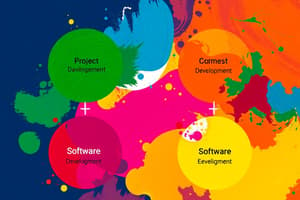Podcast
Questions and Answers
Which statement accurately describes a characteristic of the V-Model in software development?
Which statement accurately describes a characteristic of the V-Model in software development?
- It focuses more on rapid deployment than on validation.
- It allows for feedback from users only after project completion.
- It integrates risk management as a primary component in each phase.
- It emphasizes validation before each development phase. (correct)
What best describes the purpose of process patterns in software engineering?
What best describes the purpose of process patterns in software engineering?
- They are solely for defining code syntax.
- They restrict the flexibility of the development process.
- They are only applicable to large-scale projects.
- They assist in identifying and addressing common software engineering issues. (correct)
In the context of the Incremental Model, what is the primary advantage of delivering software in smaller increments?
In the context of the Incremental Model, what is the primary advantage of delivering software in smaller increments?
- It allows for user feedback and functionality enhancement in stages. (correct)
- It ensures that all software features are developed simultaneously.
- It enables risk analysis to be conducted post-completion.
- It decreases the overall project cost.
What distinguishes the Prototyping Model from other models in software development?
What distinguishes the Prototyping Model from other models in software development?
Which of the following statements accurately reflects a characteristic of the Spiral Model?
Which of the following statements accurately reflects a characteristic of the Spiral Model?
Flashcards
V-Model characteristic
V-Model characteristic
Validation occurs before each development phase in the V-Model.
Process patterns purpose
Process patterns purpose
Process patterns help find & solve common software problems.
Incremental Model advantage
Incremental Model advantage
Delivering in small parts allows ongoing user feedback & change.
Prototyping vs. other models
Prototyping vs. other models
Signup and view all the flashcards
Spiral Model characteristic
Spiral Model characteristic
Signup and view all the flashcards
V-Model
V-Model
Signup and view all the flashcards
Process Patterns
Process Patterns
Signup and view all the flashcards
Incremental Model
Incremental Model
Signup and view all the flashcards
Prototyping Model
Prototyping Model
Signup and view all the flashcards
Spiral Model
Spiral Model
Signup and view all the flashcards
Study Notes
Evolutionary Process Flow
- This process flow is iterative, meaning that it involves repeating steps to refine the software product.
Parallel Process Flow:
- This process flow allows multiple activities to be done simultaneously.
- Typically used for larger projects where multiple teams work on different tasks.
Software Development Life Cycle (SDLC) Models
- Spiral Model:
- Emphasizes risk analysis in each of its iterations.
- Best suited for large, high-risk projects.
- Linear (Waterfall) Model:
- Executes activities in a sequential order.
- Does not revisit previous steps.
- Prototyping Model:
- Starts with general objectives.
- Refines requirements through iterative feedback from users.
- V-Model:
- Emphasizes validation after each development phase.
- Focuses on testing and verification throughout the development process.
- Incremental Model:
- Delivers software in smaller, manageable increments.
- Each release adds new functionality.
SDLC Maintenance
- Includes updating software to ensure compatibility with new hardware and operating systems.
Cloud-Native Applications
- Designed specifically for cloud environments.
- Focus on scalability and flexibility.
- Leverage cloud infrastructure features.
General Software Engineering Concepts
- Process Patterns: Help identify and solve common software engineering problems.
- Cloud Computing: Enables the delivery of computing services (e.g., servers, storage, databases, networking) over the internet.
Studying That Suits You
Use AI to generate personalized quizzes and flashcards to suit your learning preferences.




